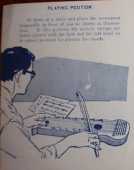
Violin-Uke
Here's one of the bowed instruments which seem to be the mainstay of Marx production in their New Troy location. These attractive little instruments carry a bit of mystery in their design. That piece that's attached at the small end of the tapered body - it sure looks like feet to me. And yet, if it were to be standing on its feet to be played, you'd have to hold on to the top of it to counteract the pressure of the bow on the strings. Then all you'd have to do is pluck the chords with your third hand... Actually, the playing instructions picture the instrument lying on a table, with player bowing with the right hand and using a thumb pick on the left for chords. So the feet apparently are for show, not standing. But they're a distinctive "feeture" that no other instrument has.

Although the shape is quite different, the architecture is the same as the ubiquitous Ukelin. A review of all patents granted to H. C. and C. H. Marx does not reveal any patent on this instrument. Judging by the soundhole labels, a patent may have been "applied for", but perhaps the instrument was too close to the Ukelin to have its own patent.
But Ukelins and Violin-Ukes went on side by side. In fact, they flourished side by side. These two instruments probably have the highest survival count of any instruments in the whole family of guitar-zithers.
Judging by the number of these remaining today, production must have been very high. It seems likely that the Marxes were building these throughout the entire length of their residence in New Troy. They appeared in a number of different forms over the years - following is a breakdown and rough approximation of manufacture dates.
Recent sale prices: Between March 2000 and March 2004, a total of 488 Violin-Ukes received bids on eBay. The average of the high bids was $29.11. (66 other Violin-Ukes received no bids.)
|
Form 1a |
Form 1b |
These two use the soundhole decal that first appeared on Phonoharp instruments not long before the formation of the International Musical Corp. (This decal actually pops up at many unexpected places.) Note that Form 1a has feet which are curved on the bottom, and Form 1b has flat feet. They'd be a bit more stable, but they'd definitely save some motions in the manufacturing process. One in Form 1a has appeared with a receipt dated 1929, and one in Form 1b with a receipt dated 1931.
|
Form 2a |
Form 2b |
Form 2c |
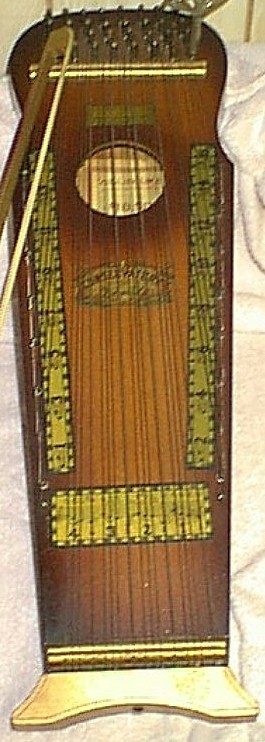 Form 2d |
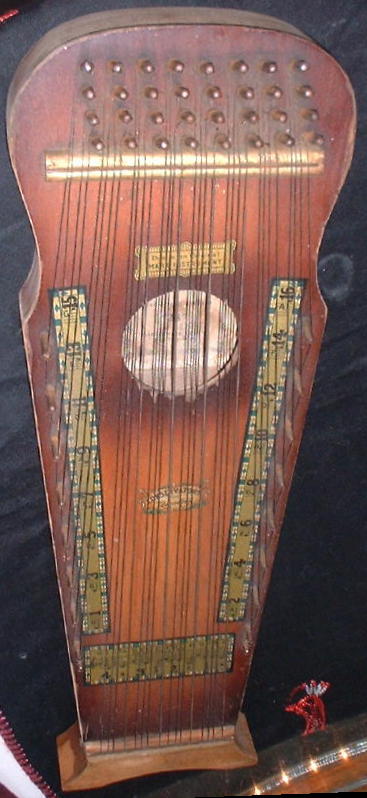 Form 2e |
These three keep the gold foot with the pinstripe. Form 2a
changes from using the soundhole decal to two different soundboard
decals, the peacock and the first form of the "original Marx" decal.
Form 2b changes all the note labels, melody and chord, to the ones used
in the final forms. Form 2c replaces the peacock with the large
"Conservatory Quality" decal. Note that it has a
gold/purple bow, even though the instrument itself is not yet gold
&
purple. This may be a replacement bow - copmany correspondence
indicates that bow longevity was a common problem.
Form 2d loses the pinstripe and Form 2e switches to the small "Conservatory Quality" decal, positioned further down the soundboard.
Form 2b has appeared with a $35 label which calls it a Marxochime.
The company seems to have been fairly relaxed about putting different
names in the same instruments, and the same name in different
instruments. (There are several other types of Marx instruments which
have appeared with a label naming the instrument "Marxochime".)
Form 2b has appeared with
|
Form 3a |
Form 3b |
This is the most common form of Violin-Uke. Gold in color, it has 4 diagonal airbrushed purple stripes, applied before the decals were put on. Sometimes both feet get a little bit of purple, sometimes just one. Other Marx instruments used a gold/purple airbrush theme, but it was never in stripes like this.) Form 3a has nothing but note labels, while Form 3b shows the "original Marx" decal.
Form 3a has appeared with
Form 3b has appeared with
|
Form 4 |
The decals are much the same as Form 3, but metallic/airbrush approach is gone and the feet and bow are plain black. Also note the shape of the body is a little different. The rounded top of the instrument extends further above the tuning pins. The top is also wider - you could continue the line of one of the tapered sides and touch the edge of the adjacent "shoulder"; on Forms 1-3, the shoulders are about the same width as the points of the body. (Notice that the instruction book shows Form 3.) This form has appeared with the unpriced Marx Music Co. label, with numbers 5178, 5560, 7781, 8287. I believe that instruments of this form were auctioned off at the factory sale in 1991.
|
Form 5a |
Form 5b |
Form 6 |
Form 7 |
And just to keep it interesting... all four of these instruments have a label inside the soundhole that says Violin-Uke. They all have the basic architecture of the Pianolin, with all of the bowed strings on one side, although the Pianolin is fully chromatic in the bowed section.
Here are many of the soundhole labels. The price varies, although it doesn't appear to necessarily rise with time. I think the marked price was just there to show the prospective customer what a great deal they'd be getting. Some labels include a 4 digit number that looks like a serial number, but it seems like there's a good chance that there were more than 9999 of these made, and instruments which are probably newer will have numbers lower than instruments which are probably older. Perhaps it's a manufacturing batch number of some sort.
(Update… my thinking on this question is changing. I've recently looked at sets of labels which were never attached to an instrument, and they were stacked in numerical order, 1 label per number. The only nagging doubt comes from being sure I've seen more than one instrument with the same number stamped inside. Perhaps it was just a goof by the person operating the rubber stamp.
Company correspondence from customers sometimes includes the serial number, but it doesn't seem to have made any difference to the company. Occasionally when someone asked how old their instrument was, and supplied a "serial number", it didn't help the company establish any particular date.)
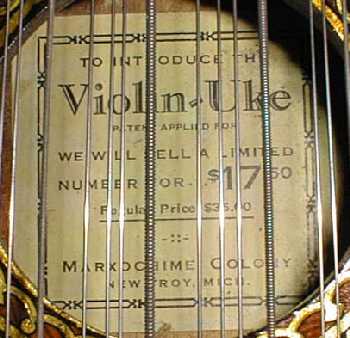
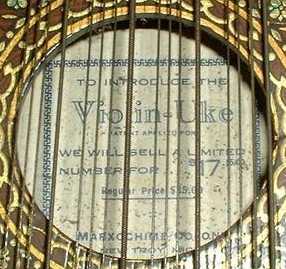

The first two are some of the earliest - they're on Form 1 instruments. At the very least, we can be sure the second one's pre-war - note the use of the swastikas for the decorative border. Note the fine print - "Regular price $35." This traveling salesman has a deal for you!

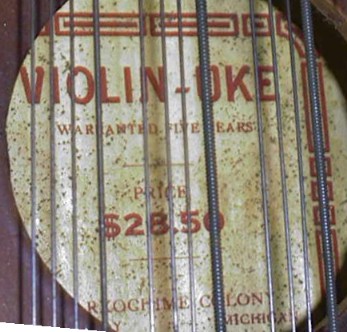

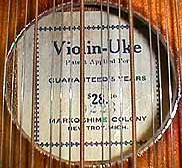

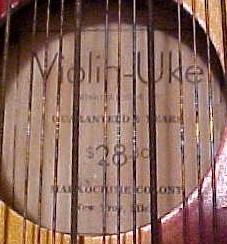
Same price, six different labels. Variations occur in the color, shape of the letters, and border.
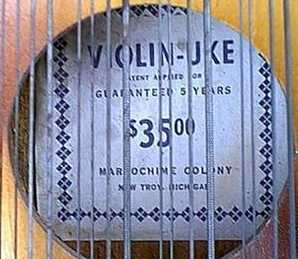

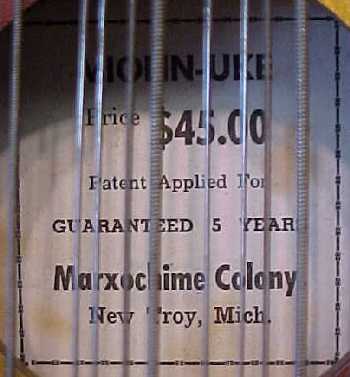
The price is rising... but I bet that salesman will still be able to cut you a deal.
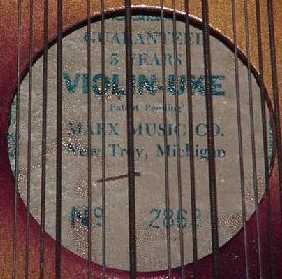
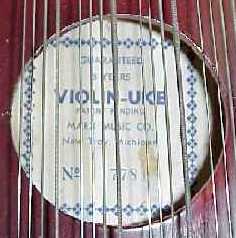
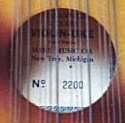
Here are some examples of unpriced labels.

And just to keep us guessing... this label has appeared in a Violin-Uke, too.
Drop me a line.
Go back to the Guitar-Zither Clearinghouse, or home.
This page was banged out with Mozilla Composer, 29 Jan 05.